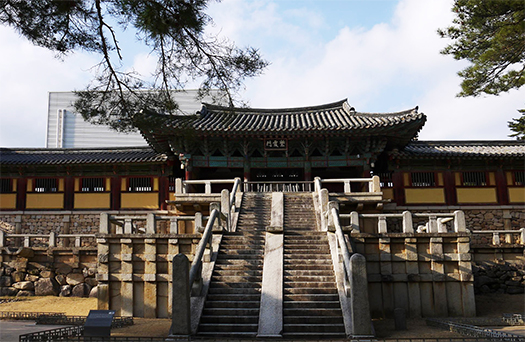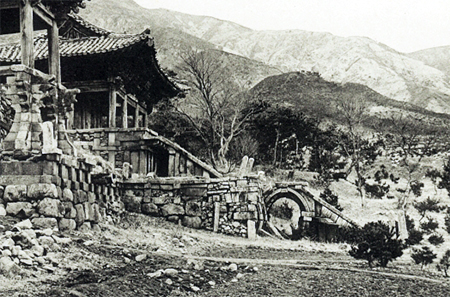


写真は韓国仏国寺の奥の院のような紫霞門に掛かる石橋・青雲橋と白雲橋。
聖なる橋の色として青雲として「青」がここで特定されているけれど、
この青とは建築の組物の着色ぶりから「緑」が想定されているように思える。
日本人も緑と青は区別がついていないように思われる。
「あおによし」と言われた奈良の都の「青」とは地域産の岩緑青で現代感覚では
緑の方がそれに相当するのだとされる。
枕詞として使われた「あお」は同時に奈良の都の植生・森の色ともいわれる。
「に」とは丹であり鮮烈な赤のことを示している。そのコントラストがあおによし。
このあたり朝鮮半島での古代の人々の色感覚はどうであったか、
先述のように組物の彩色をみると圧倒的に緑色が主流なので、やはり緑と青は
東アジア的に同様の色彩感覚であったのかと思える。興味深い。
階段の上の平面空間は宗教上の「仏国土」を表現するとされる。
娑婆世界との結界に橋が架けられているという建築表現。
本殿と言える「大雄殿」に至るこの橋を正面からみたアングル。
階段数は三十三段。33は悟りの数字とされ、努力すれば誰もが仏国土に至れる表現。
京都の名所・三十三間堂というのにはそういった意味も込められていると。
下の写真2点はサイドからのアングルで3枚目の写真は荒廃期1914年当時の様子。
1904年から1905年にかけて紫霞門左右の行廊も倒壊、1910年の日韓併合を経て
1924年4月から1925年8月迄、朝鮮総督府によって再建補修されている。
仏国寺は新羅が統一新羅になる時期751年着手〜774年に完成。
古代国家新羅は半島東南部・釜山、慶州などを本拠とする国家。
〜745年頃から750年代後半にかけて新羅で飢饉や疫病が発生し社会が疲弊した。
当時九州北部をはじめ、日本へ亡命し帰化した新羅の民が多数いた。
しかしその移民の数が多いため759年9月、天皇は大宰府に新羅からの帰化人に対し
帰国したい者があれば食料等を与えたうえで帰国させよとする勅を出した。
〜Wikipedia「新羅」の項での記述より要旨。〜
日本史ではこういった古代史上の「国際関係論」というのはほぼ教えられない。
しかし白村江という古代東アジアの「世界大戦」を沸騰点とする
国家の興隆とその外交史には日本も相当に相互関係的に関わっているし、
人的交流、関係史もまた複雑にダイナミックに展開していると思う。
ともあれ新羅国にとって仏国寺創建は国家事業(建設者は宰相)と思える。
着手から完成まで23年掛かっているのは内政危機が影響したのは間違いない。
列島国家日本では天皇家という王朝が男系継承で続いてきたけれど、
隣国では半島国家として周辺国際情勢に翻弄されざるを得ないことから、
各地に蟠踞する王朝はいくたびも易姓革命され、半島統一自体なかなか実現しない。
宗教に対する態度も、王朝自体が自ら勧請し尊崇し続けてきた日本と違って
歴世、なんども王朝が仏教を弾圧したりする。
このあたりの宗教への態度も非常に違いがあると思える。
同じように現代国家を形成しているけれど宗教・歴史文化でかなりの相異がある。
English version⬇
[Differences between peninsular nations and Japanese religious culture Horyuji and Bulguksa-8]
The photo shows Ishibashi, Seiunbashi and Hakuunbashi over the Purple Kasumi Gate, which looks like the inner temple of Bulguksa Temple in Korea.
“Blue” is specified here as the blue cloud as the color of the sacred bridge,
It seems that this blue is supposed to be “green” because of the coloring of the architectural structure.
It seems that Japanese people cannot distinguish between green and blue.
The “blue” of the capital of Nara, which was said to be “Aoyoshi,” is a local rock patina, and in a modern sense.
It is said that green is equivalent to that.
“Ao” used as a makurakotoba is also called the color of the vegetation and forest in the capital of Nara.
“Ni” means tan and bright red. The contrast is good.
How was the color sense of ancient people on the Korean Peninsula around here?
As mentioned above, when looking at the coloring of the braid, green is overwhelmingly the mainstream, so after all green and blue are
It seems that it was a similar sense of color in East Asia. Interesting.
The flat space above the stairs is said to represent the religious “French land”.
An architectural expression that a bridge is built on the barrier with the world of Sahā.
An angle from the front of this bridge leading to the main shrine, Daioden.
The number of stairs is 33. 33 is a number of enlightenment, and if you make an effort, anyone can reach the land of France.
It is said that Sanjusangendo, a famous place in Kyoto, has such a meaning.
The two photos below are from the side, and the third photo is from the devastation period of 1914.
From 1904 to 1905, the corridors on the left and right of the Shikamon Gate also collapsed, and after the annexation of Japan and Korea in 1910.
It was rebuilt and repaired by the Government-General of Korea from April 1924 to August 1925.
Bulguksa Temple started in 751 to 774 when Silla became a unified Silla.
The ancient nation Silla is a nation based in the southeastern part of the peninsula, Busan, Gyeongju, etc.
From around 745 to the latter half of the 750s, famine and epidemics occurred in Silla, and society was exhausted.
At that time, there were many Silla people who had exiled to Japan and were naturalized, including northern Kyushu.
However, due to the large number of immigrants, in September 759, the emperor sent to Dazaifu against naturalized people from Silla.
If there was a person who wanted to return to Japan, he issued a royal command to return to Japan after giving food.
~ Summary from the description in the section of Wikipedia “Silla”. ~
In Japanese history, such “international relations theory” in ancient history can hardly be taught.
However, the boiling point is the “World War” of ancient East Asia called Baekgang.
Japan is also quite interrelated in the rise of the nation and its diplomatic history,
I think that human interaction and relationship history are also complicated and dynamic.
Anyway, for Silla, the construction of Bulguksa Temple seems to be a national project (the builder is the Chancellor).
There is no doubt that the domestic crisis had an effect on the fact that it took 23 years from the start to the completion.
In the archipelago nation Japan, the dynasty called the Emperor has continued with male inheritance,
In neighboring countries, as a peninsula nation, we have no choice but to be at the mercy of the surrounding international situation.
The dynasties that crawl around the country have been revolutionized many times, and the reunification of the peninsula itself is difficult to realize.
The attitude toward religion is also different from Japan, which the dynasty itself has solicited and revered.
In the past, dynasties have cracked down on Buddhism.
It seems that the attitude toward religion around here is also very different.
Although they form a modern nation in the same way, there are considerable differences in religion and historical culture.
Posted on 9月 21st, 2021 by 三木 奎吾
Filed under: 住宅マーケティング, 歴史探訪







コメントを投稿
「※誹謗中傷や、悪意のある書き込み、営利目的などのコメントを防ぐために、投稿された全てのコメントは一時的に保留されますのでご了承ください。」
You must be logged in to post a comment.